Give your back the attention it deserves.
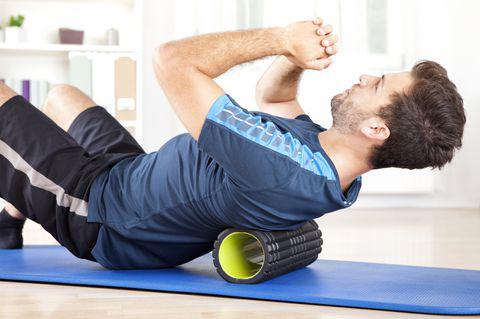
Gauert, Sebastian (Photographer). (n.d.). Man with foam roller. Getty Images.
by Dr. Rachel Tavel, PT, DPT, CSCS as seen in Men’s Health.com
Let’s face it: Our bodies’ design and the way we use them aren’t always compatible.
Our constant computer and phone use means that your head and eyes tend to be tilted downwards more than you want to admit, and definitely more than you probably realize. This forward, downward head position (aka “tech neck”) can take a serious toll on your body, leading to neck stiffness, upper and lower back pain, and even headaches.
Muscles of the upper back and neck can become tight and weak with sustained positions, limiting their strength potential and extensibility, and reinforcing bad postural habits. All that device usage leads to forward, rounded shoulders and the head resting far out in front of the shoulders instead of being stacked vertically on top of the torso. These positions, though comfortable in the short term, can actually change the alignment and health of your spine and often lead to aches and pains that become larger, more debilitating problems later on.
The best way to combat a stiff upper back is to make time for the right stretching and strengthening routine. If you’re experiencing a aches or pains in the upper back, neck or shoulders, your posture is probably to blame.
Try incorporating these stretches to unwind and open up your chest, back, and shoulders before a small ache or pain becomes a bigger problem. For some of these stretches, you’ll need a foam roller. If you don’t have one, we like this one from TriggerPoint, or any of these options.
Cat-cow Stretch
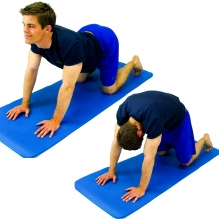
Cat Cow stretch [Digital image]. (2011). Retrieved from https://www.hep2go.com/exercise_editor.php?exId=327&userRef=gcicfednfake
The cat-cow stretch is actually two stretches in one, and a great way to self-mobilize your thoracic spine (the upper part of your back). By moving through these two poses, you can gently mobilize each vertebra so that the small bones move the way they are supposed to for daily activities and do not become too rigid and stiff.
To perform: Begin in quadruped (hands and knees) with knees under hips and hands under shoulders. Inhale as you move your sit bones up towards the ceiling, arching the back and pressing the chest towards the floor as you lift the head up. Relaxing the shoulder blades behind you. From there, inhale as you move from this “cow” position to an angry “cat” position, rounding out your back and pushing shoulder blades away from you as your spine forms a “C” curve in the opposite direction. Go through this cycle 10 times.
Side-lying Thoracic Rotation
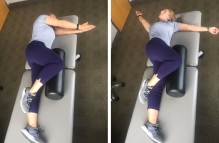
Side Lying Thoracic Rotation [Digital image]. (2018). Retrieved from https://www.hep2go.com/exercise_editor.php?exId=62127&userRef=gciaake
One of the upper back movements required for healthy mobility is rotation. With so much of life happening in an anterior-posterior or sagittal plane, the ability to twist and rotate can become limited. This stretch is a great way to improve rotation in your spine.
Begin by lying on your left side with knees bent and arms straight out in front of you, palms touching. Gently lift your right hand straight up off of the left hand, opening up the arm like it’s a book or door while following the top hand with your head and eyes until your right hand is on the other side of your body, palm up, with your head and eyes turned towards the right. Hold this stretch for a few breaths before returning to the starting position with palms facing each other. Repeat up to 10 times on each side.
Child’s Pose with Rotation
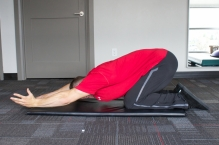

Child’s Pose and Rotation Stretch [Digital image]. (2014). Retrieved from https://www.hep2go.com/exercise_editor.php?exId=19148&userRef=gcicfednfake
Child’s pose stretches multiple muscles in the back, while also targeting the hips and even ankles.
To perform, begin on your hands and knees. Spread your knees apart while keeping your toes touching, then gently lower your hips forward towards the ground with arms outstretched in front of you. Keep your arms extended forward with palms down on the floor, lengthening the lower back. Hold this pose for several breaths.
For an added stretch, bring both hands to one side in front of you, lengthening the lats and muscles of the opposite side of your body. Repeat by reaching to the other side after a good stretch is felt. Hold each of these poses up to 30 seconds. Note: If you have pain in your knees or hips, try performing this pose while seated on a pillow or folded blanket, or try using a foam roller under your palms to make the stretch more comfortable.
Thoracic Extension Over Foam Roller/Chair

Thoracic Extension over Foam Roller [Digital image]. (2015). Retrieved from https://www.hep2go.com/exercise_editor.php?exId=23636&userRef=gcicfednfake

Thoracic Extension over Chair [Digital image]. (2018). Retrieved from https://www.hep2go.com/exercise_editor.php?exId=55041&userRef=gcicfednfake
Reverse the curve of your upper back by moving your body in the opposite direction. Find a foam roller or use the back of a chair to perform this instantly relieving stretch. If using a foam roller, place the foam roller perpendicular to your torso. Sit in front of the foam roller, and gently hammock the head with your hands, interlocking the fingers and supporting the weight of your head without pulling it.
Lean backwards so that your upper back is reaching backwards over the foam roller. Gently allow your shoulders to reach towards the floor while the foam roller supports your upper back. Carefully lift the hips to roll up and down the muscles of the upper back or move the foam roller up and inch after each stretch, leaning backwards over the roller until a gentle stretch is felt. Repeat several times, without forcing your body into discomfort. This stretch can be very intense, so start with small movement and don’t spend more than a couple minutes in this position.
Pec Stretches on Foam Roller
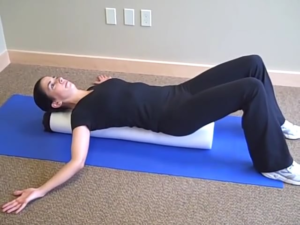
Pec Stretch on Foam Roller [Digital image]. (2012). Retrieved from https://www.hep2go.com/exercise_editor.php?exId=8119&userRef=gcicfednfake
Tight pecs can contribute to rounded shoulders and a tight upper back.
Stretch the muscles by lying on a foam roller with arms outstretched like the letter T or W. Hold for about 30 seconds in each position.
Doorway Stretch
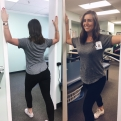
Doorway Pec Stretch [Digital image]. (2017). Retrieved from https://www.hep2go.com/exercise_editor.php?exId=48035&userRef=gcicfednfake
If you can’t find a foam roller, try using the walls of a standard doorway to stretch out the pecs.
Bring each forearm up against one side of the doorway. Gently lean forward through the doorway keeping the arms on one side to stretch out the chest. Hold for 30 seconds.
Sphinx Pose

Sphinx Pose [Digital image]. (2017). Retrieved from https://www.hep2go.com/exercise_editor.php?exId=53066&userRef=gcicfednfake
Open up the chest and back by lying on the floor and propping yourself up on your forearms.
As you inhale, gently press your forearms into the floor and lift the head and chest up. Draw your shoulders blades down and back and lengthen your tailbone. Hold for 30 seconds.
 Dr. Rachel Tavel, PT, DPT, CSCS is a Doctor of Physical Therapy, Certified Strength & Conditioning Specialist, health and fitness writer, and runner. Rachel began her career working as a travel writer in South and Central America before deciding to return to school and become a physical therapist. Her writing has appeared in multiple publications, including SELF, Huffington Post, Bustle, Greatist and several travel guidebooks.
Dr. Rachel Tavel, PT, DPT, CSCS is a Doctor of Physical Therapy, Certified Strength & Conditioning Specialist, health and fitness writer, and runner. Rachel began her career working as a travel writer in South and Central America before deciding to return to school and become a physical therapist. Her writing has appeared in multiple publications, including SELF, Huffington Post, Bustle, Greatist and several travel guidebooks.
